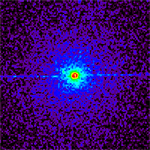More than 80% of all stars are members of multiple star systems containing two or more stars. Exactly how these systems are formed is not well understood. Some are thought to form when a collapsing cloud of gas breaks apart into two or more clouds which then become stars, or when one star captures another as a result of a grazing collision, or by a close encounter with two or more other stars.
The most common multiple star systems are those with two stars. These so-called binary stars have played an important role in many areas of astronomy, especially X-ray astronomy.
In many binary systems the stars orbit their common center of mass under the influence of their mutual gravitational force, but they evolve independently. These are called wide binaries, and are analogous to friends that are far apart and stay in touch with an occasional telephone call or e-mail on holidays. The hot upper atmospheres, or coronas, of these stars can produce X-rays, but not nearly so spectacularly as the X-ray binaries discussed below and elsewhere. Wide binaries are nevertheless important because they provide the best means for measuring the masses of stars by observing the size and period of the orbit and then applying the theory of gravity.
In some binary systems, called close binaries, the stars are so close together that they can transfer matter to each other and change the way the stars look and evolve. They are like very close friends or family members who strongly affect each other's lives.
Consider, for example, the evolution of a binary system with two massive stars, A and B, in which A is the most massive. Because of its greater mass, A will become a red giant star first. As it expands in size, star A will dump a large fraction of its mass onto star B, changing the appearance of both stars. Star A soon uses up its remaining nuclear fuel, explodes as a supernova, and leaves behind a neutron star or black hole. Later when star B becomes a red giant, material flowing onto the neutron star or black hole will produce a strong X-ray source that is called an X-ray binary. The X-ray power of an X-ray binary is millions of times that of the X-rays from normal stellar coronas.
The fate of star B varies depending on the details of its orbit and the masses of the two stars: (1) It could spiral into A to form a large black hole; (2) B could explode as a supernova and disrupt the binary system; or (3) the supernova could produce a neutron star or black hole, leading to (3a) binary neutron stars—which have been observed— (3b) a neutron star/black hole binary—which may be observed with Chandra or some other sensitive X-ray telescope, or (3c) binary black holes—which astronomers hope to observe with one of the gravitational wave detectors planned for the future.
If the masses of stars A and B are comparable to that of the Sun, the end products are white dwarfs instead of neutron stars and black holes. The dumping of matter from star A onto star B can still result in a strong X-ray source and celestial fireworks, such as a nova, or in rare cases when it transfers too much mass to the white dwarf, a supernova.




